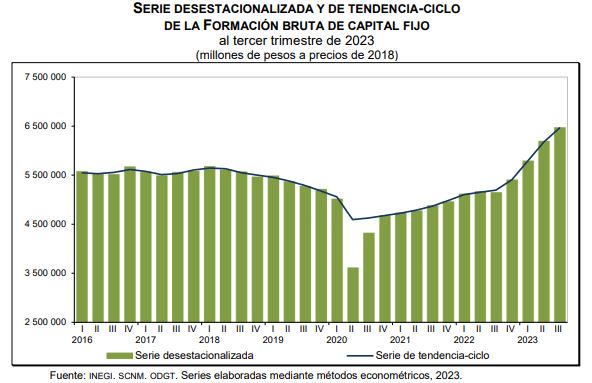Mexico‘s fixed investment in annualized terms totaled 6 trillion 427.3 billion pesos at the close of the third quarter of 2023, according to Inegi data.
This amount corresponds to constant pesos with purchasing power as of December 31, 2018 and grew at a year-on-year rate of 25.3 percent.
To note: the concept implies that the third quarter real nominal Gross Domestic Product (GDP) data has been annualized, multiplying it by four for comparative purposes.

Therefore, third quarter data are not necessarily indicative of full fiscal year performance.
Gross fixed investment is an economic indicator that measures spending on capital goods and gross fixed capital formation in an economy during a specific period.
This indicator is used to assess the level of investment in assets that are expected to last more than one year, such as buildings, machinery, equipment and other infrastructure.
Fixed Investment
According to preliminary figures, Mexico’s real GDP increased 3.3% during the third quarter of 2023 compared to the third quarter of 2022, reflecting higher external demand and higher domestic spending.
Gross Fixed Capital Formation includes the purchase of goods that producers make to increase their fixed assets, in addition to spending on improvements or refurbishments that extend the useful life or productivity of the good, valued at purchaser prices.
The goods may be purchased or produced on their own account.
They may also be items produced in the country. If so, the goods must be new (not used), or of imported origin, even if they are second-hand.
Long-term
The goods included here are constructions and works of all types, machinery and equipment in general, including transportation equipment.
Included are land, mineral deposits, timber forests and certain military expenditures.
The domestic component of gross fixed capital formation includes results from the value of quarterly construction output plus goods sold or produced for capital stock.
The measurement of gross fixed capital formation in constant values consists of the calculation of indices of real sales by type of activity, or of production, when sales are not available, for each of the 108 types of activity. They are used to extrapolate the value recorded by activity class.

